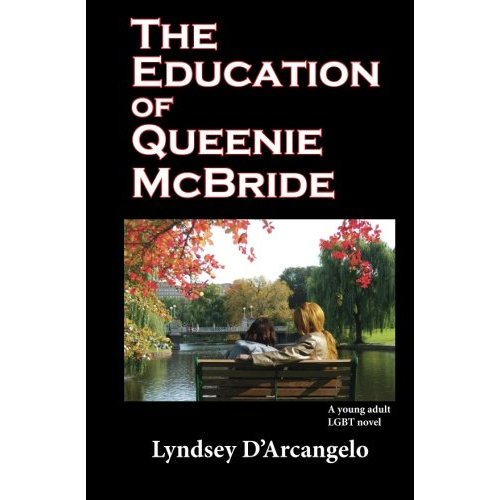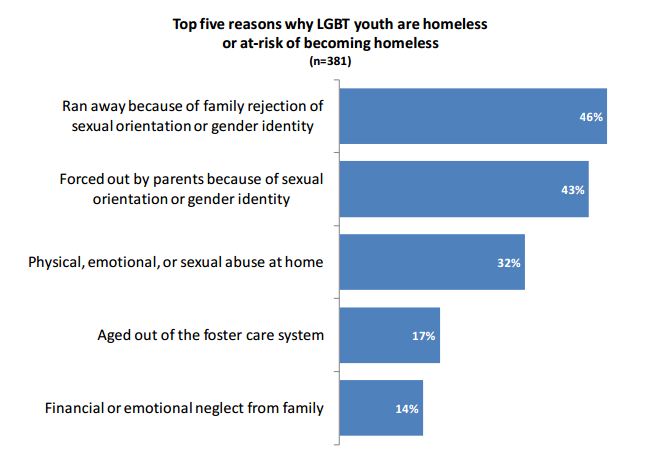Lyndsey D’Arcangelo’s new book, The Education of Queenie McBride, gives visibility to an issue that needs it: LGBT homelessness. In Queenie, much as in real life, the media and the marches fly banners and print headlines about same-sex marriage, while another American youth is getting kicked out of her home for being gay. For her, there are more pressing concerns than posting engagement photos on Facebook. That’s not to downplay the importance of legal lesbian matrimony. After all, if a gay woman is treated like a second class citizen by the government, is it really a surprise that she’s at risk of being treated as a second-class family member by those closest to her? The same prejudices that bar gays from legalized marriages bar LGBT youth from their homes.
Amazon describes D’Arcangelo’s book like this:
In this LGBT Young Adult novel, over-privileged and over-confident Queenie McBride thinks she has this whole college thing figured out. But as soon as classes begin at Boston University, she realizes that things aren’t going to be as easy as they were in her private high school. Luckily, her best friend JJ is there to help keep her in line. But when Queenie meets Pudge, a homeless LGBT teen, her entire world is forever changed. With the help of Izzy, a strong-headed and beautiful social worker, Queenie learns how to be there for Pudge, leave her old habits behind and become the person she’s always wanted to be.
Though 40% of the population isn’t gay (a girl can dream though), 40% of homeless youth are LGBT. My research into young adult books on queer homeless teens yielded few results. There are plenty of books about being young and gay, but not as many about being young, gay, and homeless. Of the 20 YA novels listed in one of our recent articles, only one, Down to The Bone directly tells the story of a gay teen getting kicked out of her home.
This is sad and disappointing because I like to think that even if you’re ignored by the mainstream media and abandoned by your family, books will be there for you, you know? Every single queer kid, no matter how marginalized, deserves shelf after shelf after shelf of books that give voice to her stories – because our stories matter, are important, and everyone should read them. So although it’s only a start, I’m very happy that a book like The Education of Queenie McBride exists.
In a recent interview with the Advocate, D’Arcangelo candidly discusses her book without letting any spoilers slip. An award-winning author and journalist, she says she wrote the book in part to fill a void in queer YA literature. As she puts it, “many teens come out and their parents support them. But just as many are kicked out of their homes for being gay and they have nowhere to go but the streets.”
A study done by the Williams Institute found that family rejection is the leading cause of homelessness among LGBT youth. D’Arcangelo, who’s spent a lot of time talking with gay youth in high schools and youth groups, has unfortunately heard the same fear echoed by teen after teen: what if coming out leads to getting kicked out? It’s infuriating that the Williams Institute study shows this fear is all too real.
Oftentimes, sexual identity intersects with race and harsh economic situations to create a web of oppression in which LGBT homeless youth find themselves entangled. The resulting statistics are not encouraging: Laura Hughes, the Executive Director of the Ruth Ellis Center, a long-term residential space specifically for runaway, homeless, and at-risk LGBT youth, reports that 40% of the youth they serve are HIV positive. Also troubling are the low high school graduation and high illiteracy rates. It’s difficult to think of how many of the teens who need D’Arcangelo’s book most may have trouble reading it.
Solving the web of racial and sexual oppression isn’t going to happen overnight, but it starts with awareness coupled with increased local, state, and federal funding to combat youth homelessness and support spaces such as the Ruth Ellis Center. This is why a government that values LGBT people is an absolute necessity, especially for queer teens on the streets. As Think Progress puts it, rather than protecting children, the anti-gay efforts led by conservative evangelical Christians may very well be causing the exact kinds of child abuse that they blame LGBT people for.
I want there to be more books like The Education of Queenie McBride, and I want there to be more teens able to access them.





Great recommendation as well as the need of more materials. Recently, in Hawaii, the government and community youth organizations came together and finally recognized the LGBTQ community for the youths because our teen suicide rate/cyber bullying were so high. A chain of problems like STDs and homelessness were also addressed…however more anecdotal conversations must remain active–then the gradual change will happen. So, I can’t agree more that it all starts locally in each state. Happy Labor day!
Sounds like a need-to-read book. I suppose my only ‘thing’ about what you’ve written concerning the book is that it’s really not about a homeless queer or trans teen, but more about how someone can support them. Which is important, but it’s even more important to actually center the experiences and lives of homeless or kicked out teens instead of making them secondary characters. This has been an issue with a number of YA books with trans characters where, because of the author’s inability to really get into the authentic voice of the trans character (or feeling it will be too alienating for non-trans readers) the book ends up being about cis people with trans people in their lives. I’ve read several YA books where the book is ostensibly supposed to be centered on a trans character but the non-trans friend or sibling just took over the story??! It’s better than nothing, but doesn’t really make the trans character flesh and blood and more about a YA social issue kind of plot. it’s a start, but trans and queer youth deserve better.
The other thing which needs saying is the reason the homelessness issue gets so underplayed by ‘gay inc.’ is because of the racial, trans and gender variant aspect to it. The reality of teen homelessness in LGBT is that it’s overwhelmingly outwardly gender variant and trans kids who are impacted the most (and kicked out the most) and they are low, low on the LGBT totem pole. And a large percentage of them (but not all) are kids of color. So yes, we need to talk about LGBT homelessness but we also have to focus on those very specific sub-communities which overwhelmingly take the brunt of societal neglect, marginalization, incarceration and violence.
This.
I volunteered at a youth homeless outreach center, which offered everything a shelter would offer except a bed. Often the youth who were in greatest difficulty were the trans* kids, because homeless shelters are almost always gender segregated, and almost always managed by Christian affiliated groups or churches. A lot of the transgirls that I talked to were transitioning socially as much as they could, which caused problems for them because men’s homeless shelters were wary of taking on a gender non-conforming youth for fear that they would get beaten up, and women’s shelters couldn’t legally take in someone who’s ID reads male. LGBT homeless shelters were few and far between and often have waiting lists. These kids often got picked on or beat up by other homeless people, had their stuff stolen repeatedly and were constantly misgendered and ragged on. All of that on top of the usual problems of being homeless, and often addictions as well.
I think most authors are very wary of writing books with protagonists from marginalised communities unless they are part of that community themselves. It’s just very difficult to convincingly convey a central character who is really far out of their own experience.
People who write books where the marginalised characters are on the edges of the story are probably people who are sincere allies, but who are justifiably anxious about ‘getting it wrong’ and perhaps offending the very people they meant to support. I think that is why Stone Butch Blues was so extraordinary in every sense of the word: because Leslie Feinberg knew the life she was writing about so intimately.
Interesting you brought Leslie Feinberg up… zie got into a huge battle with an author ‘relative’ of hirs who zie accused of exploiting hir life story for her YA book called “Jumpstart the world” (a so-so book with yet another non-trans central character and a secondary trans man character). Leslie (who was very sick at the time) published a letter saying how this sister (half-sister?… step sister?, I’m still not sure) was appropriating and twisting his story even though they had a very bad relationship and much bad blood between them. It’s a good example of people who aren’t really insiders trying to write about a marginalized community and it ending up with bad vibes all around.
Here’s a summation of affair: http://leslie-feinberg.tumblr.com/post/2748305376/while-a-hostile-relative-re-writes-my-life-who-is
For nonfiction, I really recommend Kicked Out edited by Sassafras Lowrey. It’s homeless queer youth telling their own stories, and it’s really powerful.
Hey everyone, I stumbled onto this post by accident. I’m the author of the book and the main character (Queenie) is a lesbian. This is the sequel to my first book, The Trouble with Emily Dickinson. As a lesbian myself, I wanted to write realistic LGBT fiction with gay protagonists that was relatable to both straight and gay teens. I appreciate the post, please let me know if you have any other questions about the book.
Malaika, I’d be interested to know if the statistics you mention for the states would be similar for Canada. I’m fairly familiar with issues about general homelessness, especially on the west coast, but I don’t know of any studies that look at LGBTQ youth specifically. This is a really important issue!!
I could only find this for statistics in Canada:
“Another recent study on homeless and streetinvolved youth found that in Toronto 29.6% of street youth identified as “non-straight” and 2.7% as transgendered (Gaetz, 2004, p.433)” (http://www.tyss.org/ChristineWong-Chong.pdf)
“about 40% of homeless youth in Toronto are LGBT” (http://www.diversitydufferin.com/diversity%20stats%20for%20ON%20Can.pdf)
“Rob MacDonald, project coordinator for the Host Homes Program in Ottawa Canada says that, while working with street kids, he found 30% of cases had GLBT issues.
According to the PTS & Ottawa-Carleton GLBT Health Task Group’s research for: “A Proposal for a GLBT Health/Wellness Needs Assessment and Community Resource Mapping Project”, they found that 25 – 40% of homeless youth are GLBT.” (http://www.safeschoolscoalition.org/rg-homeless.html)
I just finished reading Transparent: Love, Family, and Living the T With Transgender Teenagers by Cris Beam (at the recommendation of a fellow Autostraddler) which, while non-fiction, is not the least bit dry (it’s written like a story, I guess) and deals a lot with teens who are struggling at home/in foster care/between homes/in a group home/etc.
The only other novel I’ve come across that deals with queer youth homelessness is Jean Stewart’s Emerald City Blues. It may be a little dated now, but still worth a read.
it’s pretty cheap on kindle so I bought it and the prequel.
I know I’ve read a novel where the main character was kicked out because she was gay but I can’t for the life of me remember what it was called.
Pingback: Media Reaction to ‘Queenie’ | Lyndsey D'Arcangelo – Author & Writer from Buffalo
Pingback: Youth Homelessness In Australia – Homelessness